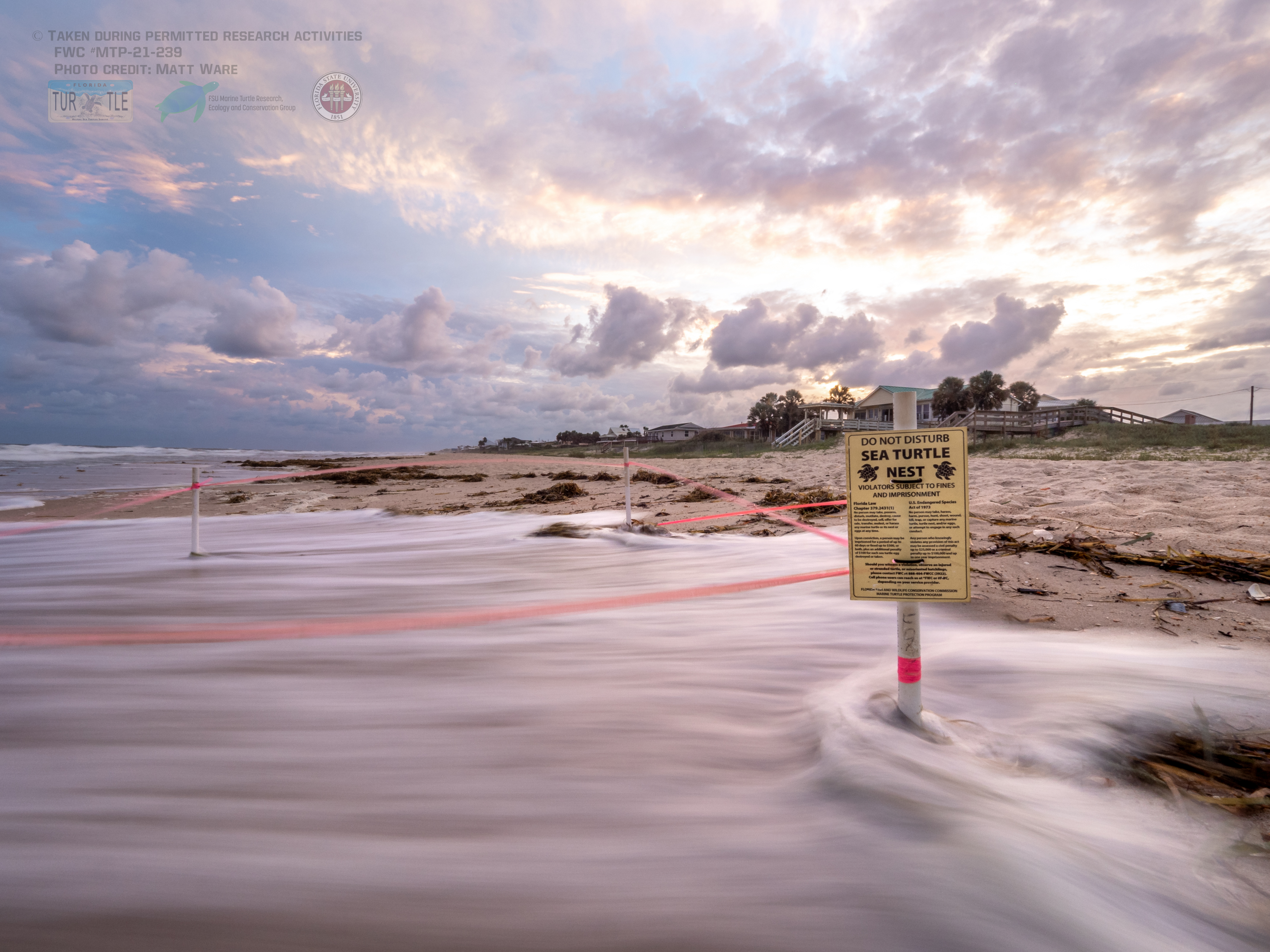Wave wash-over poses threat to endangered sea turtle nests and hatchlings

Researchers from the Florida State University Department of Earth, Ocean and Atmospheric Science have found that wave wash-over can pose a significant threat to sea turtle nests, with wave exposure potentially impacting egg incubation and hatchling productivity.
“This study was motivated by the significant number of nests along the northern Gulf of Mexico, and nesting beaches around the world, lost each year as a result of wave exposure, inundation and erosion during storms and high tides,” said Matt Ware, a coastal ecologist and FSU postdoctoral fellow.
Sustained exposure to waves may impact an embryo’s viability as well as a hatchling’s locomotive function, size, and sex – key elements that dictate whether the turtle will make its crucial first trip to the sea and indicators that it will survive into adulthood, said Ware.
Ware, who earned his doctorate in biological oceanography at FSU, worked with associate professor of oceanography Mariana Fuentes, head of the Marine Turtle Research, Ecology and Conservation Group, on the study, which was published last month in Remote Sensing.
“This project assesses wave exposure across the Florida Panhandle and is an extension of a similar project I conducted during my doctoral studies,” Ware said. “My original research, based on nests in Alabama’s Fort Morgan Peninsula, is more proof-of-concept, whereas the current project is geared towards application.”
Ware’s initial work demonstrated that empirical wave runup models could be used to inform sea turtle conservation management by identifying potentially high-risk nest locations. The current study utilizes these models, alongside data on beach slope, beach elevation, and offshore wave height, to map areas of high wave exposure and predict sites of wash-over and inundation.
“Understanding how coastal areas will be inundated can aid the management of other coastal species, like sea birds and beach mice, that may use those areas,” Fuentes said. “These results can be used to create more effective coastal development policies to better protect endangered coastal species, such as sea turtles and others.”
Nesting beaches along the 200-mile-long Panhandle coast most at-risk from wave exposure include St. Joseph Peninsula, St. Joseph Peninsula State Park, St. George Island, Cape St. George Island and Cape San Blas. Combined, these beaches represent 60 percent of loggerhead sea turtle nesting in the Panhandle and around 300 at-risk nests each year.

Approximately 96 percent of nests along this coastline are temporary homes for endangered loggerhead sea turtle eggs, and the remaining 4 percent of nests belong to other endangered species: green, leatherback and Kemp’s ridley sea turtles. Over the period surveyed, 2016 to 2019, almost half of the loggerhead nests experienced some degree of wave exposure during their two-month incubation period.
“Sea turtle eggshells are soft and leathery, which allows oxygen, carbon dioxide, water, and other elements to be exchanged between the embryo and surrounding nest environment. The embryos can ‘breathe’ in a sense,” Ware said. “When waves wash over the nest, or during heavy rain from storms and high tides, the exchange of elements is altered or stopped completely.”
Prolonged submersion can result in altered hatchling locomotor function, size, sex ratios, or death if the nest isn’t simply swept into the sea. Washed-over nests produced 46 percent fewer hatchlings than undisturbed nests, and almost 20 percent of the sea turtle nests studied were partially or completely eroded away by wave activity.
However, the research also discussed sublethal levels of wave exposure, which may be beneficial in the long run. Sea turtles have temperature-dependent sex determination — warm nests produce more female hatchlings. Wave wash-over and heavy rainfall can cool nests, producing more male hatchlings than dry nests, so as nesting beaches continue to warm and produce more female turtles, exposure may be important to ensure adequate hatching of males.

“This modeling approach isn’t just sea turtle-specific — by understanding how beaches respond to storm events or how likely a given beach’s response is to shift over decades, efforts to conserve different shore and sea species can be drastically improved,” Ware said.
Fuentes and Ware are currently conducting a follow-up project on St. George Island to further investigate the effects of beach erosion and wave exposure on sea turtle nesting ecology, specifically examining embryonic tolerance under different conditions. Their research helps recommend management actions or interventions necessary for the protection of endangered coastal and beach species.
Additional contributors to the study include Simona A. Ceriani from the Fish and Wildlife Research Institute of the Florida Fish and Wildlife Conservation Commission and Joseph Long from the Department of Earth and Ocean Sciences at the University of North Carolina at Wilmington. This study was funded by the Sea Turtle Grants Program.

